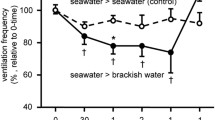Summary
The lachrymal salt glands ofChelonia mydas were functional when hatchlings emerged from the nest. Osmotic concentrations up to 720 mosmol kg−1 were recorded in spontaneously produced tears (salt gland secretions). When injected with a Na+ load (1500–2700 μmol (100 g)−1) newly emerged hatchlings produced tears ranging in osmotic concentration from 1000–1900 mosmol kg−1 with Na+ secretion rates from single glands of 200–475 μmol (100 g·h)−1. In these circumstances the rate of sodium excretion, via the salt glands, was equivalent to the sodium content of 0.2 to 0.5 ml of sea water per hour. Since the apparent drinking rate of hatchlings within the first two days of entering sea water was approximately 0.5 to 1.7 ml per day, the excretion of Na+ imbibed by drinking is well within the secretory capacity of the lachrymal salt glands.
In feeding hatchlings extraordinarily high Na+ secretion rates were induced by Na+ loading. Hatchlings which were loaded with Na+ by injection (1500–5400 μmol (100 g)−1) produced tears having osmotic concentrations between 1500 and >2000 mosmol kg−1. The Na+ secretion rates from single glands were 750–4185 μmol (100 g·h)−1 with extremely high short term rates of 10700 μmol (100 g·h)−1 (50 μmol min−1 for 28 g hatchlings).
In terms of gland mass the highest long term secretion rate translates into 21 mmol of Na+ per gram of salt gland per hour and is the highest secretion rate yet recorded for a reptilian salt gland. This rate is almost three times the highest rate recorded for sea snakes (8 mmol g·h−1) and is similar to rates commonly observed in avian salt glands (25 mmol g·h−1).
Secretion by the lachrymal salt glands was initiated by increased blood concentrations of Na+ or K+, K+ being as effective as Na+ but with the composition of the teras being virtually unchanged compared to tears from Na+ stimulated hatchlings. Preliminary experiments indicated that secretion was not initiated by increased Cl− concentration in the blood or by increased volume or osmotic concentration of the blood.
Similar content being viewed by others
Abbreviations
- O.P. :
-
osmotic pressure
References
Bennett JM (1986) A method for sampling blood from hatchling loggerhead turtles. Herp Rev 17:43
Bennett JM, Taplin LE, Grigg GC (1986) Sea water drinking as a homeostatic response to dehydration in hatchling logger-head turtlesCaretta caretta. Comp Biochem Physiol 83A:507–513
Cowan FBM (1974) Observations on extrarenal excretion by orbital glands and osmoregulation inMalaclemys terrapin. Comp Biochem Physiol 48A:489–500
Cowan FBM (1981) Effects of salt loading on salt gland function in the euryhaline turtle,Malaclemys terrapin. J Comp Physiol 145:101–198
Dunson WA (1976) Salt glands in reptiles. In: Gans C, Dawson WR (eds) Biology of the Reptilia, vol 5, Physiology A.C. Academic Press, New York London, pp 413–445
Dunson WA (1985) Effect of water salinity and food salt content on growth and sodium efflux of hatchling diamondback terrapins (Malaclemys). Phys Zool 58:736–747
Dunson WA, Dunson MK (1974) Interspecific differences in fluid concentration and secretion rate of sea snake salt glands. Am J Physiol 227:430–438
Holmes WN, McBean RL (1964) Some aspects of electrolyte excretion in the green turtle,Chelonia mydas mydas. J Exp Biol 41:81–90
Holmes WN, Phillips JG (1985) The avian salt gland. Biol Rev 60:213–256
Holmes WN, Phillips JG, Chester Jones I (1963) Adrenocortical factors associated with adaptation of vertebrates to marine environments. Rec Prog Horm Res 19:619–672
Hyatt AD, Marshall AT (1977) Sequestration of haemolymph sodium and potassium by fat body in the water-stressed cockroachPeriplantea americana. J Insect Physiol 23:1437–1441
Kooistra TA, Evans DH (1976) Sodium balance in the green turtle,Chelonia mydas, in sea water and fresh water. J Comp Physiol 107:229–240
Marshall AT, Hyatt AD, Phillips JG, Condron RJ (1985) Isosmotic secretion in the avian nasal salt gland: X-ray microanalysis of luminal and intracellular ion distributions. J Comp Physiol B 156:213–227
Marshall AT, King P, Condron RJ, Phillips JG (1987) The duct system of the avian salt gland as a transporting epithelium: structure and morphometry in the duckAnas platyrhynchos. Cell Tissue Res 249:179–188
Minnich JE (1979) Reptiles. In: Maloiy GMO (ed) Comparative physiology of osmoregulation in animals, vol I. Academic Press, London New York San Francisco, pp 391–641
Peaker M, Linzell JL (1975) Salt glands in birds and reptiles. Cambridge University Press, London
Prange HD (1985) Renal and extra-renal mechanisms of salt and water regulation of sea turtles: a speculative review. Copeia 1985:771–776
Prange HD, Greenwald L (1980) Effects of dehydration on the urine concentration and salt gland secretion of the green sea turtle. Comp Biochem Physiol 66A:133–136
Schmidt-Nielsen K, Fange R (1958) Salt glands in marine reptiles. Nature 182:783–785
Author information
Authors and Affiliations
Rights and permissions
About this article
Cite this article
Marshall, A.T., Cooper, P.D. Secretory capacity of the lachrymal salt gland of hatchling sea turtles,Chelonia mydas . J Comp Physiol B 157, 821–827 (1988). https://doi.org/10.1007/BF00691014
Accepted:
Issue Date:
DOI: https://doi.org/10.1007/BF00691014




